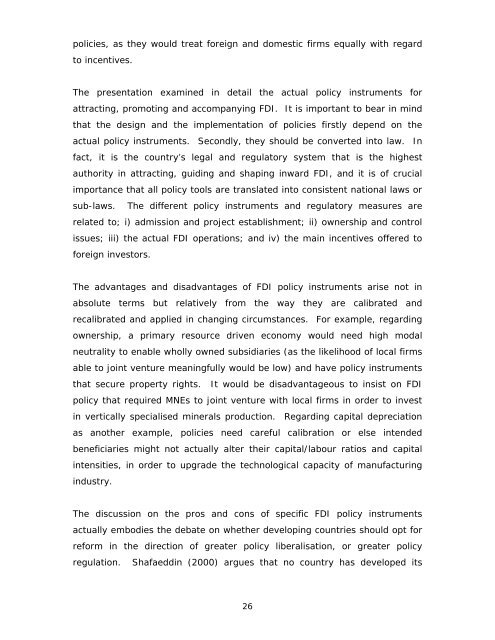(EGM) Foreign Direct Investment in Southeast Asia - Unido
(EGM) Foreign Direct Investment in Southeast Asia - Unido
(EGM) Foreign Direct Investment in Southeast Asia - Unido
You also want an ePaper? Increase the reach of your titles
YUMPU automatically turns print PDFs into web optimized ePapers that Google loves.
policies, as they would treat foreign and domestic firms equally with regard<br />
to <strong>in</strong>centives.<br />
The presentation exam<strong>in</strong>ed <strong>in</strong> detail the actual policy <strong>in</strong>struments for<br />
attract<strong>in</strong>g, promot<strong>in</strong>g and accompany<strong>in</strong>g FDI. It is important to bear <strong>in</strong> m<strong>in</strong>d<br />
that the design and the implementation of policies firstly depend on the<br />
actual policy <strong>in</strong>struments. Secondly, they should be converted <strong>in</strong>to law. In<br />
fact, it is the country’s legal and regulatory system that is the highest<br />
authority <strong>in</strong> attract<strong>in</strong>g, guid<strong>in</strong>g and shap<strong>in</strong>g <strong>in</strong>ward FDI, and it is of crucial<br />
importance that all policy tools are translated <strong>in</strong>to consistent national laws or<br />
sub-laws. The different policy <strong>in</strong>struments and regulatory measures are<br />
related to; i) admission and project establishment; ii) ownership and control<br />
issues; iii) the actual FDI operations; and iv) the ma<strong>in</strong> <strong>in</strong>centives offered to<br />
foreign <strong>in</strong>vestors.<br />
The advantages and disadvantages of FDI policy <strong>in</strong>struments arise not <strong>in</strong><br />
absolute terms but relatively from the way they are calibrated and<br />
recalibrated and applied <strong>in</strong> chang<strong>in</strong>g circumstances. For example, regard<strong>in</strong>g<br />
ownership, a primary resource driven economy would need high modal<br />
neutrality to enable wholly owned subsidiaries (as the likelihood of local firms<br />
able to jo<strong>in</strong>t venture mean<strong>in</strong>gfully would be low) and have policy <strong>in</strong>struments<br />
that secure property rights. It would be disadvantageous to <strong>in</strong>sist on FDI<br />
policy that required MNEs to jo<strong>in</strong>t venture with local firms <strong>in</strong> order to <strong>in</strong>vest<br />
<strong>in</strong> vertically specialised m<strong>in</strong>erals production. Regard<strong>in</strong>g capital depreciation<br />
as another example, policies need careful calibration or else <strong>in</strong>tended<br />
beneficiaries might not actually alter their capital/labour ratios and capital<br />
<strong>in</strong>tensities, <strong>in</strong> order to upgrade the technological capacity of manufactur<strong>in</strong>g<br />
<strong>in</strong>dustry.<br />
The discussion on the pros and cons of specific FDI policy <strong>in</strong>struments<br />
actually embodies the debate on whether develop<strong>in</strong>g countries should opt for<br />
reform <strong>in</strong> the direction of greater policy liberalisation, or greater policy<br />
regulation. Shafaedd<strong>in</strong> (2000) argues that no country has developed its<br />
26

















